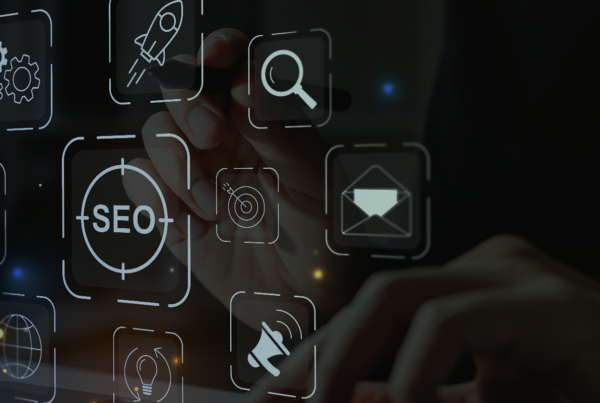Whether it’s all about automation and artificial intelligence and privacy/security, or it’s touching on targeting different kinds of audiences — from B2B to B2C to how to bridge the gap between different platforms and their audiences — the Paid Search landscape has, and will continue to evolve.
Just like any other marketing strategy, there will always be the up and coming platforms and new technologies with Paid Search being no different. However, how we pair them best to the proven initiatives is what we, as digital marketers, are uncovering and gathering a better understanding so that we can achieve brilliant results with Paid Search.
Part of the Paid Media Team here at Logical digs into some of the most pressing topics and themes we’ve seen in Paid Media, but Paid Search specifically. Interested? Read along with us on the following topics…

Colleen, Senior Paid Media Strategist
Paid Search Automation
Automation plays a lot of roles in paid search. Some are very straightforward such as setting a rule to pause or enable a campaign on a certain day or time. Some forms of automation in paid search are a little less obvious.
Google Ads utilizes many types of automations from bid strategies to what combination of an ad is served to a user. Here are some of the most utilized automations in paid search.
Bidding Strategies
Google Ads’ automated bidding strategies, or Smart Bidding, mean bids on ad groups or keywords don’t need to be manually updated. Instead, in an automated bid strategy, Google Ads will automatically update your bid based on the ad’s likeliness to result in a click or conversion.
So, choosing the right automated bid strategy based on your goal — whether it be clicks to drive awareness or conversions to drive purchases — helps campaigns optimize efficiently around that goal.
Responsive Search Ads(RSAs)
Responsive Search ads can have up to 15 headlines and 4 descriptions. Google will use these assets and serve a combination of 3 headlines and 2 descriptions that are most likely to get engagement from a user from their particular search.
This helps to ensure ads are as relevant to users’ searches as possible. Headlines and descriptions can be updated as needed to help improve ad strength and to align with keywords and landing pages more closely.
Automatically Created Assets
If opted into, Google Ads can automatically create ad copy, extensions or add images from your website to help increase ad performance.
Automation in paid search ads can more efficiently help campaigns optimize toward goals and help ensure ads are relevant to user’s searches. However, with auto-generated assets, we need to ensure they are relevant to the campaign or brand… and that they make sense. This is done through auditing keywords and ad copy as well as extension audits. While automation simplifies some aspects of paid search, we’ll always need the human element to ensure that ad copy and assets make sense but also to help ensure campaigns are optimizing efficiently toward the right goals.

Julian, Paid Media Strategist
Emergence of AI in Search Campaigns
Artificial Intelligence (AI) is reshaping paid search campaigns, bringing about efficiency and innovation. Here, we look at how AI-powered algorithms excel at refining targeting strategies, analyzing user behavior, and optimizing advertising budgets and more features.
Precision Targeting
AI analyzes massive datasets to accurately predict user search intent, allowing marketers to tailor campaigns to specific audience needs. We can input large search keywords into AI platforms, which then analyze the keywords being used by competitors (or not being used!) to take advantage of it.
Personalization at Scale
Machine learning algorithms customize content, ad copy, and landing pages, enhancing user engagement and conversion rates.
Budget Optimization
AI adjusts bids, dynamically, in real-time, optimizing ad spend and maximizing return on investment depending on the time and days when people are interacting more with ad campaigns.
Voice Search Adaptation
AI enables campaigns to cater to the trend of voice-activated searches.
The use of AI in paid search campaigns is a game-changer, cultivating a data-driven, customer-centric approach. Not only that, but amongst paid search and social, AI will allow for campaigns to be even more effective for the brand-side as well as relevant to the users. A note, though, is that with all of AI and machine learning in its (likely) infancy, it’s crucial to verify and not 100% trust the tools.
By design, AI and its emergence in paid search and social and organic search (SEO) is a great way to enhance the work of digital marketers — they are extensions of the work and not a replacement of humans.

Ben, Paid Media Team Lead
Evolution of Targeting B2B and B2C Audiences
Over the past two decades, B2B (business-to-business) and B2C (business-to-consumer) marketing have undergone profound transformations, driven by the rapid evolution of digital technologies and shifts in consumer and business behaviors.
B2B Targeting
In the B2B landscape, a digital revolution has unfolded, ushering in an era where online platforms, data analytics, and personalized content have become central to marketing strategies.
- Digital transformation in B2B has enabled companies to leverage new channels for advertising, lead generation, and customer engagement. Email marketing, social media, and search engine optimization (SEO), play crucial roles in reaching and connecting with B2B audiences.
- Content marketing has become a cornerstone of B2B. Companies create and share valuable, relevant content to establish thought leadership, educate prospects, and nurture leads. Blogging, whitepapers, webinars, and other content formats help build trust and credibility.
- Account-Based Marketing (ABM) has risen to prominence, offering a targeted approach to engage specific accounts, while social media has assumed a crucial role in connecting with professionals.
B2C Targeting
Simultaneously, B2C marketing has been significantly shaped by technological advancements, changes in consumer behavior, and the evolving landscape of communication channels.
- E-Commerce has fueled a tremendous growth in online shopping. E-commerce platforms have become central to B2C marketing, offering consumers the convenience of shopping from anywhere at any time.
- Mobile has led to the widespread adoption of smartphones and has revolutionized B2C marketing. Mobile apps, mobile-optimized websites, and location-based services have become integral for reaching and engaging consumers on their preferred devices.
- Social media platforms have become crucial for B2C marketers to connect with consumers, build brand awareness, and drive engagement. Platforms like Facebook, Instagram and TikTok provide opportunities for targeted advertising, influencer partnerships, and community building.
These transformations underscore a shared reliance on technology, data-driven insights, and a commitment to personalized, impactful communication strategies. B2B and B2C marketing have adapted to the evolving preferences of their respective audiences, navigating an ever-changing digital landscape with innovation and strategic acumen.

Braden, Paid Media Team Lead
Analytics and Privacy in Paid Media
Historically, third-party cookies have been instrumental in enabling digital marketers to track users across different websites, collecting data on their browsing habits to deliver targeted ads.
However, this practice has raised substantial privacy concerns, as it often occurs without explicit user consent or awareness, leading to a growing demand for greater control over personal data. This depreciation process has been going on for years before Google Chrome’s big announcement as this cookie tracking overhaul has started as early as Q1 of 2020.
Here’s a brief timeline of some of the most popular internet browser’s abiding by the updates to user’s desires for data control:
March 2020: Apple’s Safari blocks the use of Third Party Cookies
September 2021: iOS14 Updates to Apple users require permissions to now be granted to be tracked by cookies entirely
June 2022: Firefox Browser turned on it’s “Total Cookie Protection Feature”
January 2024: Google Chrome depreciates 1% of users Third Party Cookies
Q4 2024: Google Chrome set to remove all Third Party Cookie Tracking
This move symbolizes a broader recognition of the fundamental right to privacy, acknowledging that personal data is not merely a commodity, but an extension of the individual’s identity.
The biggest impact this has on digital marketers is the loss of efficiency in being able to track and attribute performance to campaigns due to loss of data visibility.
Of course, overcoming this challenge is going to heavily rely on an adjustment in mindset as to how paid media can be utilized primarily by adopting first-party data strategies coinciding with the use of advancing AI Algorithmic Machine Learning capabilities on all available platforms.

Tyler, Marketplace Strategist
The Intersection of Amazon and Paid Advertising
With Amazon’s growth these past few years (who didn’t buy something during the Pandemic on Amazon?!), it’s a very competitive market out there.
Many sellers have been investing in advertising through the Amazon ads console in order to garner the additional visibility and traffic. As a result, target cost per click (CPC)s have continued to rise and it has gotten more and more expensive to place a product at the top of the search results. With all of this in play, sellers have started to look outside of Amazon for opportunities to drive additional traffic to their product pages via search engines & social media.
There are several benefits to expanding advertising beyond Amazon’s walls. Despite the behemoth marketplace boasting 4.7 billion visits in December 2023, Google saw 168 billion visits during the same period.
With many online shoppers starting on Google, sellers have found it beneficial to start testing out ad placements through Google, Bing, Facebook, Instagram, Pinterest & more.
Benefits of Amazon Advertisers integrating with other Platforms
Additional traffic
By utilizing these other platforms, sellers can start driving traffic that otherwise would not have seen their products.
Improved organic ranking on Amazon
As product pages receive more traffic, especially from external sources, this can incentivize the Amazon algorithm to improve organic product placements on their website.
Potentially lower CPCs
As mentioned previously, with how cluttered Amazon sponsored ads have become in recent years, sellers may experience less cost per click due to a lower level of competition for keyword targets.
With all this in mind and starting with a low budget, expanding advertising efforts to search and social platforms is a low-risk experiment that sellers could benefit greatly from testing.
What Does All Of This Mean?
With the amount of digital marketing progress that is happening at near-lightspeed, it can be difficult to slow down and take stock of where you are at, and, with a strategy in mind, where to focus your efforts alongside new technologies and ways of approaching Paid Search.
Here at Logical, we are a data-driven agency that takes advantage of the new tools and advancements that are moving the Paid Search landscape ahead while also keeping the proven ways close.
If you’re looking for a Paid Search partner to work with, along with our team members found here, you’re in the right place. Reach out to us for a chat on your digital marketing and Paid Search needs.








